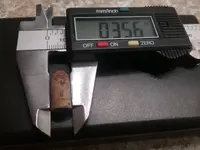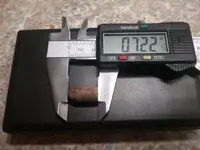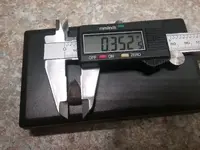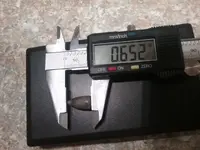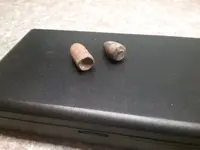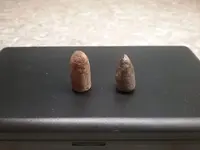You are using an out of date browser. It may not display this or other websites correctly.
You should upgrade or use an alternative browser.
You should upgrade or use an alternative browser.
✅ SOLVED Conical bullet type and age ?
- Thread starter villagenut
- Start date
Red James Cash
Banned
- Joined
- Aug 20, 2009
- Messages
- 12,824
- Reaction score
- 7,901
- Golden Thread
- 0
- Location
- New Hampshire
- Detector(s) used
- Garret Master hunter Cx Plus
- Primary Interest:
- Other
The first one is a (looks jacketed) .38. Should be .357.
Upvote
0
TheCannonballGuy
Gold Member
- Joined
- Feb 24, 2006
- Messages
- 6,607
- Reaction score
- 13,455
- Golden Thread
- 0
- Location
- Occupied CSA (Richmond VA)
- Detector(s) used
- White's 6000, Nautilus DMC-1, Minelab
- Primary Interest:
- Relic Hunting
Your bullet #1 is a .32 rifle cartridge bullet and most likely was made sometime between about 1900 to 1950. I think it's for a rifle because its length-versus-diameter ratio is quite long... pistol bullets tend to be shorter in comparison to their diameter (width). The key time-dating clue is the multiple tiny parallel ridges (called reeding or knurling) in the bullet's body-groove. The earliest appearance of that feature on bullets seems to have been 1878, according to my extensive research on that feature. (But, as I indicated in another post, I do not believe I already know everything there is to know.) Reeded grooves, also called a knurled cannelure, did not become "commonly seen" on bullets until about 1890-1900. The reason I'm guessing production of your bullet seems to have stopped "around" 1950 or so is, although your bullet has been posted many-many times for ID in the What-Is-It? forum, I've never seen a "fresh-looking" one.
IMPORTANT NOTE for diggers who measure their bullets with a Caliper (which they should do) when trying to correctly ID the bullet:
Although Villagenut's photo shows his bullet #1 in the jaws of a Caliper saying its diameter is .356-inch, its ORIGINAL 32-caliber diameter has been ENLARGED by two factors. First, it is a fired bullet, with raised ridges on its body created by the gunbarrel's rifling-grooves. Second, there is typically about .01-inch of lead-oxide patina "buildup" on excavated bullets. In summary, the bullet was fired through a .32"-diameter gunbarrel, the raised rifling-ridges add "about" .02-inch to the fired bullet's diameter, and the patina adds "about" .01-inch to the bullet's diameter.
Bullet #2 is from the first half of the 1800s into the civil war. It is a type called a "Country Rifle" bullet in the McKee-&-Mason book on civil war bullets. That book shows many varieties of "Country Rifle" bullets, and many calibers/diameters. Called a "Country Rifle" bullet because it was by-far mostly used by Civilian game-hunters, not soldiers.
IMPORTANT NOTE for diggers who measure their bullets with a Caliper (which they should do) when trying to correctly ID the bullet:
Although Villagenut's photo shows his bullet #1 in the jaws of a Caliper saying its diameter is .356-inch, its ORIGINAL 32-caliber diameter has been ENLARGED by two factors. First, it is a fired bullet, with raised ridges on its body created by the gunbarrel's rifling-grooves. Second, there is typically about .01-inch of lead-oxide patina "buildup" on excavated bullets. In summary, the bullet was fired through a .32"-diameter gunbarrel, the raised rifling-ridges add "about" .02-inch to the fired bullet's diameter, and the patina adds "about" .01-inch to the bullet's diameter.
Bullet #2 is from the first half of the 1800s into the civil war. It is a type called a "Country Rifle" bullet in the McKee-&-Mason book on civil war bullets. That book shows many varieties of "Country Rifle" bullets, and many calibers/diameters. Called a "Country Rifle" bullet because it was by-far mostly used by Civilian game-hunters, not soldiers.
Last edited:
Upvote
0
villagenut
Gold Member
- #6
Thread Owner
CBG.....gotta thank you so much for your well worded comments and research and knowledge. There are several members here who likewise go over and beyond to help others out in this way.....and they know who they are Anyways, we all appreciate what you bring here and this information you provided helps immensely, thanks again,vn.
Anyways, we all appreciate what you bring here and this information you provided helps immensely, thanks again,vn.
 Anyways, we all appreciate what you bring here and this information you provided helps immensely, thanks again,vn.
Anyways, we all appreciate what you bring here and this information you provided helps immensely, thanks again,vn.
Upvote
0
villagenut
Gold Member
- #7
Thread Owner
So would this country rifle bullet been crimped into a casing like a rimfire? It looks as if it were made in a mold and then dropped before ever being made ready for firing 

Upvote
0
Lunch Bag
Full Member
- Joined
- Dec 23, 2018
- Messages
- 147
- Reaction score
- 391
- Golden Thread
- 0
- Location
- Coastal Georgia
- Detector(s) used
- XP DEUS
- Primary Interest:
- Relic Hunting
CBG.....gotta thank you so much for your well worded comments and research and knowledge. There are several members here who likewise go over and beyond to help others out in this way.....and they know who they areAnyways, we all appreciate what you bring here and this information you provided helps immensely, thanks again,vn.
Absolutely agree with this truthful statement.
Having so many experienced experts on this site is what makes it such a valuable resource.
Upvote
0
Yak1366
Bronze Member
- Joined
- Oct 22, 2017
- Messages
- 1,293
- Reaction score
- 2,307
- Golden Thread
- 0
- Location
- Ringgold, Georgia
- Detector(s) used
- Equinox 800, Garrett ATPro, ProPointer AT, Retriever II
- Primary Interest:
- Other
Very nice finds, Congrats!!!
Great info TCBG!!!
Great info TCBG!!!
Upvote
0
TheCannonballGuy
Gold Member
- Joined
- Feb 24, 2006
- Messages
- 6,607
- Reaction score
- 13,455
- Golden Thread
- 0
- Location
- Occupied CSA (Richmond VA)
- Detector(s) used
- White's 6000, Nautilus DMC-1, Minelab
- Primary Interest:
- Relic Hunting
Villagenut asked:
> So would this country rifle bullet been crimped into a casing like a rimfire?
First... Smokeythecat answered your bullet-ID request, saying it is a "picket style" bullet... and the McKee-&-Mason book calls it a "Picket type for country rifle"... so I want her to get public credit for giving you its general ID. More specifically, your bullet is shown in that book as bullet #163, except yours is a smaller-caliber version of it. In particular, note that it is shown in that book's Base-type #2 section... meaning, a solid flat base which has "rounded" edges. Seeing that type of base on your bullet is what led me to its correct ID.
I should mention... a lot of folks tend to "overlook" that book's Base-type #2 section, because unlike the other base-type categories in the book, Base-type #2 does not start at the top of a page... and there are only a few bullets in the Base-type 2 category. So, guys, don't forget about that section in the McKee-&-Mason book, shown at the bottom of page 30.
Getting back to your question (quoted above)… no, it was not "crimped into a casing like a rimfire." ALL of the country-rifle bullet varieties had a paper cartridge.
> It looks as if it were made in a mold and then dropped before ever being made ready for firing?
It was made in a lead-casting mold, but it wasn't dropped. The spot on its base which looks like damage is where the casting sprue was kinda crudely removed by the guy who cast your bullet.
Now don't y'all go Democrat/Progressive Politically-Correct on me for saying "the GUY who cast your bullet." Very-very few women ever did rifle-bullet casting, handling molten lead, until in wartime desperation the Confederate Ordnance Department employed some women to help manufacture munitions... notably, bullet-&-cartridge production in Richmond.
Very-very few women ever did rifle-bullet casting, handling molten lead, until in wartime desperation the Confederate Ordnance Department employed some women to help manufacture munitions... notably, bullet-&-cartridge production in Richmond.
Sidenote: I re-worded some parts of the second paragraph in my first reply-post to you in this thread, to clarify their meaning. So, you might want to re-read that paragraph.
Lastly... my thanks go out to y'all for the recognition and praise you've given for my efforts here in the What-Is-It? forum.
> So would this country rifle bullet been crimped into a casing like a rimfire?
First... Smokeythecat answered your bullet-ID request, saying it is a "picket style" bullet... and the McKee-&-Mason book calls it a "Picket type for country rifle"... so I want her to get public credit for giving you its general ID. More specifically, your bullet is shown in that book as bullet #163, except yours is a smaller-caliber version of it. In particular, note that it is shown in that book's Base-type #2 section... meaning, a solid flat base which has "rounded" edges. Seeing that type of base on your bullet is what led me to its correct ID.
I should mention... a lot of folks tend to "overlook" that book's Base-type #2 section, because unlike the other base-type categories in the book, Base-type #2 does not start at the top of a page... and there are only a few bullets in the Base-type 2 category. So, guys, don't forget about that section in the McKee-&-Mason book, shown at the bottom of page 30.
Getting back to your question (quoted above)… no, it was not "crimped into a casing like a rimfire." ALL of the country-rifle bullet varieties had a paper cartridge.
> It looks as if it were made in a mold and then dropped before ever being made ready for firing?
It was made in a lead-casting mold, but it wasn't dropped. The spot on its base which looks like damage is where the casting sprue was kinda crudely removed by the guy who cast your bullet.
Now don't y'all go Democrat/Progressive Politically-Correct on me for saying "the GUY who cast your bullet."
 Very-very few women ever did rifle-bullet casting, handling molten lead, until in wartime desperation the Confederate Ordnance Department employed some women to help manufacture munitions... notably, bullet-&-cartridge production in Richmond.
Very-very few women ever did rifle-bullet casting, handling molten lead, until in wartime desperation the Confederate Ordnance Department employed some women to help manufacture munitions... notably, bullet-&-cartridge production in Richmond.Sidenote: I re-worded some parts of the second paragraph in my first reply-post to you in this thread, to clarify their meaning. So, you might want to re-read that paragraph.
Lastly... my thanks go out to y'all for the recognition and praise you've given for my efforts here in the What-Is-It? forum.
Last edited:
Upvote
0
villagenut
Gold Member
- #11
Thread Owner
Awesome information CBG....I have learned just enough to be dangerous,lol.
Upvote
0
villagenut
Gold Member
- #12
Thread Owner
Not quite sure on the first one, but I believe the smaller one is a picket style bullet.
Thanks Smokey, the Picket bullet has turned out to be a nice history lesson now that I have been reading up

Upvote
0
TheCannonballGuy
Gold Member
- Joined
- Feb 24, 2006
- Messages
- 6,607
- Reaction score
- 13,455
- Golden Thread
- 0
- Location
- Occupied CSA (Richmond VA)
- Detector(s) used
- White's 6000, Nautilus DMC-1, Minelab
- Primary Interest:
- Relic Hunting
HuntinDog wrote:
> CBG
> Thank you
You're welcome.
> My CRS keeps me from remembering all of this and if it weren't for you and others I'd just be guessing...
That is why I am very glad TreasureNet keeps ALL of a member's posts in an "individual" archive, which can be viewed simply by clicking on the poster's member-name (at left of your screen, above the Avatar picture), then click on the "View Forum Posts" option. Wanting the knowledge I've shared here to survive my mortal body (I'll soon be 70), and being mindful that all of my past TN posts are archived for public viewing, I've been careful to post almost nothing but artifact-ID answers. (That is honestly the reason why, perhaps to the disappointment of some people, I've done almost no chit-chat posts nor "Nice find!" posts.) I've deliberately restrained myself from doing social-talk posts in order to make it easy for TN readers to find ID-answers in TN's archive of TheCannonballGuy posts... instead of having to read through forty-'leven "Hey, that's a nice find!" posts to sift out the relic-ID ones.
Thus, my 5,400+ What-Is-It? forum posts are the final relic-ID book I'll write. I want the archive of my TN posts to be a good follow-up to my North/South Trader Civil War magazine (and other magazine) articles and book "Field Artillery Projectiles Of The American Civil War."
I hope none of the above sounds maudlin. I just want y'all to know "specifically" what's been in my mind as I've become elderly with major health issues, regarding the legacy I'll leave behind.
Regards to all of y'all,
Pete George
"TheCannonballGuy"
> CBG
> Thank you
You're welcome.

> My CRS keeps me from remembering all of this and if it weren't for you and others I'd just be guessing...
That is why I am very glad TreasureNet keeps ALL of a member's posts in an "individual" archive, which can be viewed simply by clicking on the poster's member-name (at left of your screen, above the Avatar picture), then click on the "View Forum Posts" option. Wanting the knowledge I've shared here to survive my mortal body (I'll soon be 70), and being mindful that all of my past TN posts are archived for public viewing, I've been careful to post almost nothing but artifact-ID answers. (That is honestly the reason why, perhaps to the disappointment of some people, I've done almost no chit-chat posts nor "Nice find!" posts.) I've deliberately restrained myself from doing social-talk posts in order to make it easy for TN readers to find ID-answers in TN's archive of TheCannonballGuy posts... instead of having to read through forty-'leven "Hey, that's a nice find!" posts to sift out the relic-ID ones.
Thus, my 5,400+ What-Is-It? forum posts are the final relic-ID book I'll write. I want the archive of my TN posts to be a good follow-up to my North/South Trader Civil War magazine (and other magazine) articles and book "Field Artillery Projectiles Of The American Civil War."
I hope none of the above sounds maudlin. I just want y'all to know "specifically" what's been in my mind as I've become elderly with major health issues, regarding the legacy I'll leave behind.
Regards to all of y'all,
Pete George
"TheCannonballGuy"
Upvote
0
Similar threads
- Replies
- 3
- Views
- 659
Users who are viewing this thread
Total: 1 (members: 0, guests: 1)

